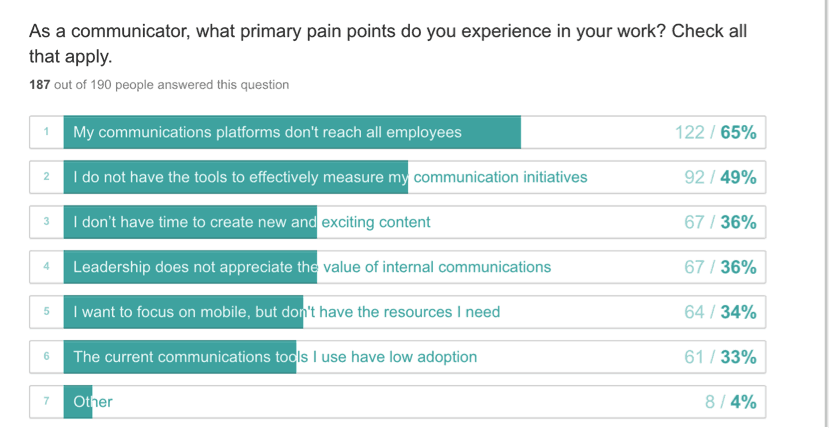Internal enterprise communications are getting more and more challenging by the day. As technology drives changes to the work environment, reaching all employees at once has become a major “pain point.” CEOs are increasingly relying on their communications teams to smooth the transition — 87% say that fostering employee alignment with strategic change is key, and 84% say increasing employee engagement is a primary objective.
But while communications expectations are rising, budgets for communicators are stagnant or shrinking. On average, there are four communicators for every 10,000 employees — a huge imbalance. With such a ratio, data about effective employee communications is crucial — but only 15% surveyed are satisfied with their ability to measure employee response. Still, there is enormous room to increase leadership communication skills with sharp thinking and foresight.
Communications thought leader Sharon McIntosh, President of And Then Communications, recently partnered with Firstup for a webinar outlining how to not just survive, but thrive as a modern communicator. McIntosh drew her lessons from decades of experience in multinational business settings, running and advising communications teams. She laid out five key points for anyone who wants to transform from a trusted communications advisor to an enterprise change manager.
Leadership communication that inspires: Skills every leader needs

How to become a better communicator
1. Strategic planning is necessary. It may seem like day-to-day needs are more pressing, but McIntosh advises starting to plan for the next year tomorrow. Your strategy should be built on business goals, not communication goals. McIntosh says to go back and check everything you’ve sent out in the last few days. If it doesn’t connect to any business goal, you shouldn’t have been writing it. This will all take time — but it’s time well spent, because it gets you focused on what’s important, instead of staying in a reactive mode 24/7.
2. Work like an operations manager. You can’t focus solely on employees with computers — deskless workers are just as crucial to operations. Think about the content that different employees in different contexts need. If you don’t know, find out. Ask how they receive the info the CEO wants to give, but learn what they want to hear, too.
3. Think like a marketer. How would you do things differently if you treated employees like consumers? What if they had to buy your communication as a product? Content would be more interesting, less patronizing, and more transparent, McIntosh suggests. You are competing for your employees’ attention against external media, as well — and they have the expectation that your content will be just as easy to consume.
4. Internal communicators can be partners to drive change. Everybody is undergoing some kind of transformation — primarily around the shift to digital. Leadership leans on communicators to implement change, but given their centrality to company-wide flows of information and behavior, they can be drivers, too. If you’re going to roll out a mobile app, for example, one email isn’t going to cut it. You need to think holistically and long-term about the stakeholders and the desired change in behavior.
5. Be an enterprise analyst. How do you know if your strategies are working? By generating metrics corresponding to your goals. Stop measuring output and start measuring outcomes: what behavioral change do you want to see? McIntosh suggests setting benchmark questions and tracking their progress to generate numbers you can present to senior leadership.
Your role as a communicator is more important than ever before. Find energy by being your employees’ ambassador to leadership. Leadership needs you, too, and by executing these strategies you can become their trusted advisor. It may feel like you’re in an impossible situation, fending off contradictory demands. But McIntosh shows that transforming your strategic stance can unlock time and efficiency to thrive in your role. Embrace your potential as the beating heart of your entire company, and seize the responsibility of actively managing and driving change.
Download PDF








